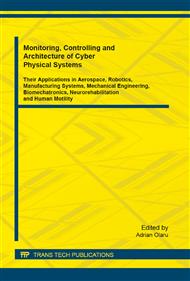[1]
Michael Wooldridge, An introduction to Multiagent Systems, John Wiley & Sons, (2002).
Google Scholar
[2]
H. Van Dyke Parunak, A Practitioner's Review of Industrial Agent Applications, Autonomous Agent and Multi-Agent Systems, 2000, Vol. 3, no. 4, pp.389-407.
DOI: 10.1023/a:1010002720057
Google Scholar
[3]
Michal Pechoucek, Vladimir Marik, Industrial deployment of multi-agent technologies: review and selected case studies, Autonomous Agent and Multi-Agent Systems, 2008, vol. 17, no. 3, pp.397-431.
DOI: 10.1007/s10458-008-9050-0
Google Scholar
[4]
W. Shen, Q. Hao, H. J. Yoon, D. H. Norrie, Applications of agent-based system in intelligent manufacturing: An updated review, Advanced Engineering Informatics 20, 2006, pp.415-431.
DOI: 10.1016/j.aei.2006.05.004
Google Scholar
[5]
I. Timm, T. Scholz, O. Herzog, Capability-based emerging organization of autonomous agents for flexible production control, Advanced Engineering Informatics 20, 2006, pp.247-259.
DOI: 10.1016/j.aei.2006.01.008
Google Scholar
[6]
Vladimir Marik, Duncan McFarlane, Industrial Adoption of Agent-Based Technologies, Journal IEEE Intelligent Systems Volume 20 Issue 1, January 2005, pp.27-35.
DOI: 10.1109/mis.2005.11
Google Scholar
[7]
V. Marik, J. Lazansky, Industrial aplications of agent techologies, Control Engineering Practice 15, 2007, pp.1364-1380.
Google Scholar
[8]
Stuart Boyer, SCADA: Supervisory Control and Data Acquisition, 3-rd ed., ISA, (2004).
Google Scholar
[9]
G. Clarke, D. Reyders, E. Wright, Practical SCADA Protocols, Elsevier, (2004).
Google Scholar
[10]
Donghyun Choi, Hybrid Key Management Architecture for Robust Scada Systems, Journal of Inf. Sc. and. Eng., 27, pp.197-211, (2011).
Google Scholar
[11]
David Bailey, Edwin Wright, Practical SCADA for Industry, Elsevier, (2003).
Google Scholar
[12]
E. M. Davidson, S. D. J. McArthur, J. R. McDonald, T. Cumming, I. Watt, Applying multi-Agent System Technology in Practice: Automated Management and Analysis of SCADA and Digital Fault Recorder Data, IEEE Transactions on Power Systems, vol. 21, No. 2, May 2006, DOI: 10. 1109/TPWRS. 2006. 873109.
DOI: 10.1109/tpwrs.2006.873109
Google Scholar
[13]
F. Bellifemine, G. Caire, A. Poggi, G. Rimassa, JADE: A software framework for developing multi-agent applications. Lessons learned, Inf. and Soft. Technology 50 (2008) pp.10-21, doi: 10. 1016/ j. infsof. 2007. 10. 008.
DOI: 10.1016/j.infsof.2007.10.008
Google Scholar
[14]
S. Calderwood, W. Liu, J. Hong and M. Loughlin, An Architecture of a Multi-Agent System for SCADA, - dealing with uncertainty, plans and actions, Proceedings of the 11th International Conference on Informatics in Control, Automation and Robotics (ICINCO'13), pp.300-306.
DOI: 10.5220/0004594603000306
Google Scholar
[15]
R. Bordini, J. Hubner, M. Wooldridge, Programming multi-agent systems in AgentSpeak using Jason, Wiley, (2007).
DOI: 10.1002/9780470061848
Google Scholar
[16]
Arnon Rotem-Gal-Oz, Fallacies of Distributed Computing Explained, 1994, http: /www. rgoarchitects/Files/fallacies. pdf, http: /arnon. me/presentations-papers-articles/, accessed (2014).
Google Scholar
[17]
Fred Hebert, Learn You Some Erlang For Great Good! A beginner's Guide, No Starch Press, (2013).
Google Scholar
[18]
A. S. Rao, Michael P. Georgeff, BDI Agents: From Theory to Practice, Technical Note 56, Australian Art. Int. Inst., Proc. of the First Int. Conf. on Multi-Agent Systems (ICAS-95), (1995).
Google Scholar
[19]
Rao AS, AgentSpeak(L): BDI agents speak out in a logical computable language, in Proc. of the Seventh Workshop on Modelling Autonomous Agents in a Multi-Agent World (MAAMAW'96), 22-25 January, Eindhoven (ed. Van de Velde W and Perram J), vol. 1038 of LNAI, p.42.
DOI: 10.1007/bfb0031841
Google Scholar
[20]
W. R. Wobcke, Reasoning about BDI Agents from a Programming Languages Perspective,. Proceedings of the AAAI 2007 Spring Symposium on Intentions in Intelligent Systems, 2007, pp.48-53.
Google Scholar
[21]
Bratman, M. E. (1999).
Google Scholar
[1987]
Intention, Plans, and Practical Reason. CSLI Publications. ISBN 1-57586-192-5.
Google Scholar
[22]
P. Novak, P. Kadera, P. Vrba, R. Sindelar, Architecture of a Multi-Agent System for SCADA Level in Smart Distributed Environments, 2013 IEEE Conference on Emerging Technologies & Factory Automation (ETFA), 10-13 sept 2013, Cagliari, ISSN: 1946-0740, ISBN: , 978-1-4799-0864-6, pp.1-9.
DOI: 10.1109/etfa.2013.6647950
Google Scholar
[23]
Brendan Galloway, Gerhard P. Hancke, Introduction to Industrial Control Networks, Communications Surveys & Tutorials, IEEE (Volume: 15 , Issue: 2 ), ISSN: 1553-877X, pp.860-880, INSPEC: 13475582, DOI: 10. 1109/SURV. 2012. 071812. 00124.
DOI: 10.1109/surv.2012.071812.00124
Google Scholar


